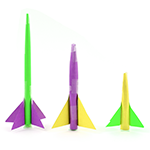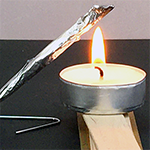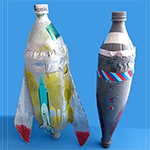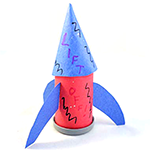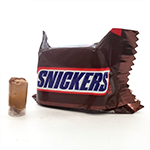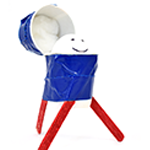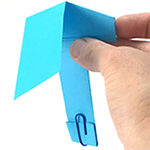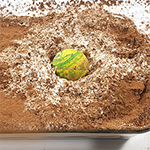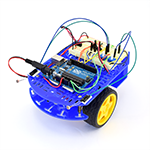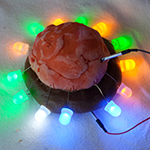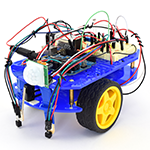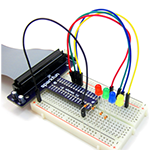Mission to Mars: Summer of STEM (Week 9)
Join Science Buddies this summer for virtual summer camp! Each week, we'll have a fun STEM theme for kids of all ages, suggestions for simple hands-on activities, book picks, and more. With our Summer of STEM, we'll keep you and your kids inspired all summer with creative and innovative science and engineering activities — for free. This week: go on a Mission to Mars with space-themed science!
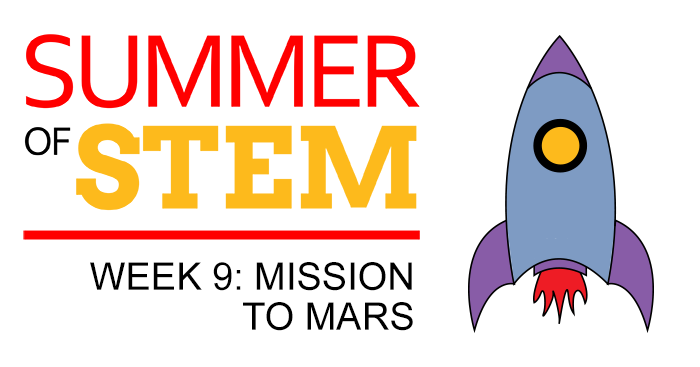
A Mission to Mars with Space Science
On NASA's upcoming Mars 2020 mission, the Perseverance rover will be heading to Mars to collect rock and soil samples. The launch window is scheduled for July 30, with the rover targeted to land on the Jezero Crater on Mars in February 2021. Once on the Red Planet, the Perseverance rover will be spending close to two Earth years exploring the geology of the planet.
The Perseverance rover, which is about the size of a car and weighs more than 2,000 pounds, has 19 camera systems and 7 new instruments that will be used and tested on the mission, including a SuperCam "that can provide chemical composition analysis and mineralogy at a distance"; the Mastcam-Z camera system "with panoramic and stereoscopic imaging capability"; Mars Oxygen In-Situ Resource Utilization Experiment (MOXIE), "a technology demonstration that will produce oxygen from Martian atmospheric carbon dioxide"; and the Mars Environmental Dynamics Analyzer (MEDA) to monitor weather, climate, and dust on Mars. NASA hopes that Perseverance's tools will help pave the way for future human missions.
The Ingenuity Mars Helicopter will also be catching a ride to Mars on Perseverance. Once there, the robotic helicopter, which weighs in at about 4 pounds, will be used to test the possibility of flight on Mars.
(See the links at the bottom of this page for more information about the Mars 2020 mission.)
This week, kids can explore science and engineering related to space science, including rocket science, robotics, and astronomy. With hands-on activities that help kids understand some of the questions and research that will be part of the Mars 2020 mission, this week will inspire kids and help them see science and engineering in the context of real space exploration.
Tip: This downloadable PDF contains a summary of the ideas for Week 9. Print this out and use it as a check-list for activities you try this week! You can also print and use our simple activity log (PDF) if you want to encourage your younger students to reflect on their activities.
ASK: Science Questions for Week 9
Use these questions to prompt conversation and reflection this week about the Mission to Mars — Space Science activities:
- How does a year on Mars compare to a year on Earth in duration? (How many days is in a Mars year?)
- What areas of science are involved in preparing for and conducting a mission like Mars 2020? Which of these areas interest you? Why?
- Why is it important to learn more about the composition of rocks and soil on other planets?
- What are some of the challenges engineers have to think about in controlling robotic equipment like Perseverance and Ingenuity from Earth?
- Which science or engineering activity did you try? What did you learn?
- What kinds of STEM jobs are related to the space science STEM activities you explored this week?
DO & EXPLORE: Rocket Science for Week 9
- Explore Matchstick Rockets: make tiny rockets from aluminum foil and matchsticks and learn more about propulsion and Newton's third law of motion.
- Build a Paper Rocket: make simple paper rockets that launch by blowing into a drinking straw. What changes to the design of a paper rocket will make it fly farthest?
- Rocket Science: How High Can You Send a Payload?: what is a rocket's payload? Turn a water bottle into a rocket with compartments for fuel and payload and explore the role of each.
- Launching Homemade Baking Soda Rockets: experiment to see how changes in the ratio of baking soda to vinegar affect the launch distance of a film canister rocket.
- Build a Two-Stage Balloon Rocket: make a balloon rocket to find out why a rocket has stages in which parts of it fall off and burn up in the atmosphere.
- Bottle Rocket Blast Off!: use a water bottle rocket launcher to model how a rocket's reaction engine creates thrust and propels a rocket into space.
DO & EXPLORE: Mission to Mars — Space Science Activities
- Candy Core Samples: according to NASA, the Perseverance rover will be taking rock core samples that are "about the size of a piece of chalk" and collecting them for possible return to Earth. With this activity, kids can act like geologists and drill their own core samples from candy bars.
- Make a Whirlybird from Paper and Flying Helicopters on Mars: make paper whirlybirds to explore how the spinning of a helicopter's blades create lift. What do lift and gravity have to do with how a helicopter flies? What difference will the atmosphere on Mars make for a helicopter? What design features might be especially important in thinking through helicopter flight on Mars?
- Protect Your 'Eggstronaut': Build an Egg-Drop Lander: after a successful launch, the potential of a space mission like Mars 2020 has a lot to do with whether or not the Perseverance rover makes it safely to the surface of Mars. In this activity, kids build their own reusable egg-drop lander to see if they can protect an egg being dropped from a high location.
- Creating Craters: the Perseverance rover is scheduled to land in the Jezero Crater on Mars, one of thousands of impact craters on the planet's surface. What causes an impact crater and what can we tell by analyzing the size of craters? Make your own craters in this activity to explore! (This activity can be messy. You might try it outdoors. It's also a great opportunity for doing some fun slow-motion video filming with a cell phone.)
Tip: Curious about craters on Mars compared to Earth? Do a bit of research to see how many craters scientists estimate are on Mars, how many are on Earth, and how the sizes compare. To get you started, know that Mars has more than 43,000 impact craters that are greater than 3 miles in diameter, but that's not even close to the total number of craters on the planet! The largest crater, the Hellas Impact Crater, is about 1,400 miles across!
- How Big Are the Planets in Our Solar System?: there are only eight planets in our solar system, but some of them are dramatically different in size. Make a model to see how the planets compare in size.
- Model the Distances between Planets in our Solar System: after launch, it will be many months before the Perseverance lands on Mars. How far away is Mars? How far away are the other planets in our solar system? Make a model of the planets and their distances to see how far away they really are. (Fun fact: It took Voyager 2 twelve years to reach Neptune after launching from Earth in 1977!)
- Mars Rover Obstacle Course: once on Mars, the Perseverance rover and the Ingenuity helicopter will be controlled by scientists and engineers on Earth. In this activity, kids think through some of the challenges involved in remotely controlling robotic systems.
WATCH: Videos for Week 9
These videos demonstrate activities highlighted for Week 9's Mission to Mars — Space Science theme:
These videos are not from Science Buddies but tie in with this week's theme:
- New Mars Curiosity Rover Pictures (ElderFox Documentaries)
- The Curious Life of a Mars Rover (National Geographic)
- Hubble: Galaxies Across Space and Time (Hubble Space Telescope)
- Diamonds in the Sky: Stars and Exoplanets (Smithsonian National Air and Space Museum)
EXPLORE with KITS
The following Science Buddies Kits fit in with this week's Mission to Mars — Space Science theme. These science and engineering kits provide the specialty materials kids need for a variety of fun explorations, including robotics, computer programming, and electronics:
- BlueBot 4-in-1 Robotics Kit: The BlueBot 4-in-1 Robotics Kit is a great option for kids interested in robotics and in the kinds of robotic vehicles used in space exploration and on the surface of a planet. The BlueBot kit can be used to build four different robotic vehicles, each using a different sensor: Motion-Activated Guard Robot, Speedy Light-Tracking Robot, Zippy Line-following Robot, and Obstacle-Avoiding Robot.
With the addition of Arduino and other specialty parts, kids can extend their exploration to see what's involved in building and programming "smart" robots. The following projects help get kids started thinking about ways to take their robots to the next level:
- Build a Solar-Tracking Robot: many spacecraft and planetary rovers are solar-powered. By combining Arduino and the BlueBot Kit, kids can build and program their own solar-tracking robot. (Note: this project requires the BlueBot Kit and additional supplies, including an Arduino Uno.)
- Build an Arduino Robot: in this freeform project, students are challenged to take their BlueBot robots to the next level by adding a programmable microcontroller like an Arduino. (Depending on the individual project, students will need the BlueBot Kit and additional supplies.)
- Raspberry Pi Projects Kit: the tools, vehicles, and instruments that are part of Mars 2020 involve lots of computer programming. With the Raspberry Pi Projects Kit, kids build their own Raspberry Pi computer and then learn how to code using Scratch and circuit-building for a progressive series of eight activities in which they program and build interactive toys, devices, and art. (For families that already own a Raspberry Pi, the Circuit Building Kit for Raspberry Pi is available.)
- Electric Play Dough Kit: use insulating and conductive doughs to experiment with basic circuits by making light up creative sculptures — even model planets!
- Crystal Radio Kit: you won't be able to pick up stations from outer space, but you can tune in to local AM stations with a crystal radio you build yourself!
Learn more about Science Buddies Kits and see our 12 Science Kits for Summer Science Experiments and Discovery recommendations.
READ: Books to Pair with Week 9's Mission to Mars — Space Science Theme
- 30-Minute Robotics Projects by Loren Bailey
- 30-Minute Rainy Day Science Projects by Loren Bailey
- A Computer Called Katherine: How Katherine Johnson Helped Put America on the Moon by Suzanne Slade (Author), Veronica Miller Jamison (Illustrator)
- Ada Lace, Take Me to Your Leader (3) by Emily Calandrelli, Tamson Weston
- A Hundred Billion Trillion Stars by Seth Fishman (Author), Isabel Greenberg (Illustrator)
- Always Looking Up: Nancy Grace Roman, Astronomer by Laura Gehl (Author), Louise Pigott (Illustrator), Alex Oxton (Illustrator)
- Come Back to Earth, Esther! by Josée Bisaillon
- Counting on Katherine: How Katherine Johnson Saved Apollo 13 by Helaine Becker (Author), Dow Phumiruk (Illustrator)
- Frankenbots: Stu Saves The World by Michael Ferrone (Author, Illustrator)
- Galaxy Girls: 50 Amazing Stories of Women in Space
- How to Catch a Star by Oliver Jeffers
- I am Neil Armstrong by Brad Meltzer (Author), Christopher Eliopoulos (Illustrator)
- Katherine Johnson (You Should Meet) by Thea Feldman (Author), Alyssa Petersen (Illustrator)
- Mae Among the Stars by Roda Ahmed (Author), Stasia Burrington (Illustrator)
- Margaret and the Moon by Dean Robbins (Author), Lucy Knisley (Illustrator)
- Mousetronaut Goes to Mars by Mark Kelly (Author), C. F. Payne (Illustrator)
- Reaching for the Moon: The Autobiography of NASA Mathematician Katherine Johnson by Katherine Johnson (Author)
- The Girl Who Named Pluto: The Story of Venetia Burney by Alice B. McGinty (Author), Elizabeth Haidle (Illustrator)
- The Way Back Home by Oliver Jeffers
- There Was An Old Astronaut Who Swallowed the Moon! by Lucille Colandro (Author), Jared Lee (Illustrator)
- Rosie Revere, Engineer by Andrea Beaty (Author), David Roberts (Illustrator)
- What Miss Mitchell Saw by Hayley Barrett (Author), Diana Sudyka (Illustrator)
- Who Was Neil Armstrong? by Roberta Edwards (Author)
Tip! Oobleck gets its name from Bartholomew and the Oobleck by Dr. Seuss!
For other great STEM stories for summer reading, see our Book list for science-filled summer reading! post. Also, don't miss this roundup of creative STEM activities for storytelling and imaginative play.
Learn More about the Mars 2020 Mission
Find out more about Mars 2020, the Perseverance rover, and the Ingenuity Helicopter with the NASA links below:
- Mars 2020
- Mars 2020 Mission Overview
- Virginia Middle School Student Earns Honor of Naming NASA's Next Mars Rover
- 6 Things to Know About NASA's Ingenuity Mars Helicopter
- Perseverance Fact Sheet
Note for Teachers: You'll find Lesson Plans for some of this week's rocket science explorations linked in the Rocket Science Activities post.
Summer of STEM Posts
- Week 1 - Carnival Science
- Week 2 - Gadgets & Gizmos
- Week 3 - Wizards & Magic
- Week 4 - Artists & Makers
- Week 5 - Fireworks & Picnics
- Week 6 - Water Play
- Week 7 - Superhero Science
- Week 8 - Strange but True Science
- Week 9 - Mission to Mars
- Week 10 - Backyard Science
Categories:
You Might Also Enjoy These Related Posts:
- 12 Science Kits for Summer Science Experiments and Discovery
- Ready, Set, Go! (Awesome Summer Science Experiments)
- Awesome Summer Science Experiments
- Deep Dive into STEM—Do a Summer Science Project!
- Imagine Your Story - STEM Activities for Storytellers of All Ages!
- Carnival STEM (Awesome Summer Science Experiments)
- Wacky Water Science (Awesome Summer Science Experiments)
- Radiant Rainbows (Awesome Summer Science Experiments)


